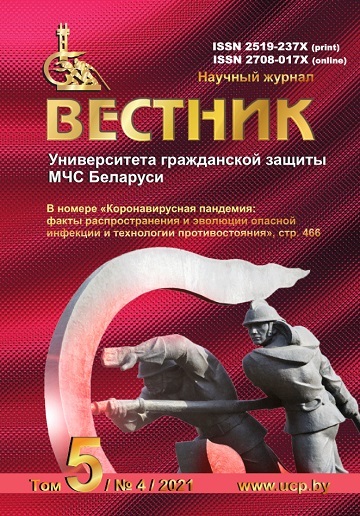Влияние алгоритма взаимодействия автоматических установок пожаротушения и противодымной вентиляции на время блокирования эвакуационных путей и эффективность локализации пожара в помещениях высокостеллажного хранения
DOI:
https://doi.org/10.33408/2519-237X.2021.5-4.387Ключевые слова:
автоматическая установка пожаротушения, противодымная вентиляция, склад с высокостеллажным хранением, видимость при пожаре, эвакуационный путь, численное моделированиеАннотация
Цель. На основе численного моделирования пожара в помещении склада с высотным стеллажным хранением определить оптимальный алгоритм взаимодействия автоматических установок пожаротушения (АУПТ) и противодымной вентиляции (ПДВ) по времени блокирования эвакуационных путей и эффективности локализации пожара.
Методы. В работе применены теоретические методы исследования (анализ, синтез, сравнение), а также выполнено численное моделирование в расчетном программном комплексе Fire Dynamics Simulator.
Результаты. В результате численного моделирования пожара в помещении склада с высотным стеллажным хранением резинотехнических изделий размерами 60×50×14 м и высотой складирования пожарной нагрузки 12,5 м определен оптимальный алгоритм взаимодействия АУПТ и ПДВ по времени блокирования эвакуационных путей и эффективности локализации пожара, а именно: оросители АУПТ размещаются только во внутристеллажном пространстве, при этом запуск противодымной вентиляции производится от АУПТ. Данная схема защиты позволяет локализовать очаг пожара без распространения на соседние стеллажи и удерживать его мощность на минимальном уровне, а также увеличить время блокирования продуктами горения и термического разложения путей эвакуации в горизонтальной плоскости помещения на высоте 1,7 м в среднем в 1,3 раза и эвакуационного выхода в той же плоскости в 1,7–2,9 раза по сравнению с иными вариантами взаимодействия АУПТ и ПДВ.
Область применения исследований. Полученные результаты могут быть использованы для определения алгоритмов взаимодействия составных элементов систем пожарной автоматики при защите складов с высотным хранением материалов.
Библиографические ссылки
Meshman L.M. Vliyanie sistemy protivodymnoy ventilyatsii na rabotu avtomaticheskikh ustanovok pozharotusheniya [Influence of smoke ventilation on operation of automatic fire extinguishing units]. ABOK. 2016. No. 4. Pp. 32–37. (rus)
Thomas P.H., Hinkley P.L. Design of roof-venting systems for single-storey buildings. London: HMSO, 1971.
Hinkley P.L., Hansell G., Marshall N.R., Harrison R. Sprinklers and Vents Interaction. Experiments at Ghent. Fire Surveyor. 1992. Pp. 18–23.
Hinkley P.L. The Effect of Vents on the Opening of the First Sprinklers. Fire Safety Journal. 1986. Vol. 11, No 3. Pp. 211–225. DOI: https://www.doi.org/10.1016/0379-7112(86)90064-0.
Cooper L.Y. Smoke and Heat Venting. Ed. by P.J. DiNenno [et al.]. 3rd ed. Quincy, Massachusetts: National Fire Protection Association. 2008. Ch. 3. Рp. 3-236–3-240.
Cooper L.Y. The interaction of an isolated sprinkler spray and a two-layer compartment fire environment. Phenomena and model simulations. Fire Safety Journal. 1995. Vol. 25, No. 2. Pp. 89–107. DOI: https://www.doi.org/10.1016/0379-7112(95)00037-2.
Cooper L.Y. The interaction of an isolated sprinkler spray and a two-layer compartment fire environment. International Journal Heat and Mass Transfer. 1995. Vol. 38, No. 4. Pp. 679–690. DOI: https://www.doi.org/10.1016/0017-9310(94)00188-2.
McGrattan K., Miles S. Modeling Enclose Fires Using Computational Fluid Dynamics (CFD). Ed. by P.J. DiNenno [et al.]. 4th ed. Quincy, Massachusetts: National Fire Protection Association. 2008. Ch. 3. Рp. 3-229–3-247.
Dekterev A.A., Gavrilov A.A., Litvintsev K.Yu., Amel'chugov S.P., Seregin S.N. Modelirovanie dinamiki pozharov v sportivnykh sooruzheniyakh [Simulation of the dynamics of fires in sports facilities]. Fire safety. 2007. No. 4. Pp. 49–58. (rus)
Ryzhkov A.M. [et al.]. Primenenie polevogo metoda matematicheskogo modelirovaniya pozharov v pomeshcheniyakh. Metodicheskie rekomendatsii [Application of the field method for mathematical modeling of indoor fires. Guidelines]. Moscow: FGBU VNIIPO EMERCOM of Russia, 2002. 35 p. (rus)
Koshmarov Yu.A. Prognozirovanie opasnykh faktorov pozhara v pomeshchenii [Prediction of hazardous factors of fire in a room]: textbook. Moscow: State Fire Academy of EMERCOM of Russia. 2000. 118 p. (rus)
Korol'chenko A.Ya., Korol'chenko D.A. Pozharovzryvoopasnost' veshchestv i materialov i sredstva ikh tusheniya [Fire and explosion hazard of substances and materials and means of their extinguishing]: handbook: in 2 parts. 2nd ed., revised. Moscow: Association «Pozhnauka». 2004. Part 2. 774 p. (rus)
Опубликован
Как цитировать
Лицензия
Все права защищены (c) 2021 Суриков А.В., Калантарли А.Т., Рябцев В.Н., Лихоманов А.О.

Это произведение доступно по лицензии Creative Commons «Attribution-NonCommercial» («Атрибуция — Некоммерческое использование») 4.0 Всемирная.




















